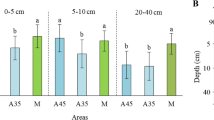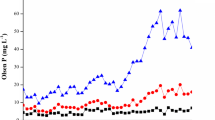Abstract
In the rolling pampa region, the intensification of beef cattle feeding operations generates large volumes of solid organic manure which has high concentrations of phosphorus (P). This residue can be reused like organic fertilizer in agricultural practices, increasing crop production and closing the nutrients cycle. However, this practice can cause water pollution if not well managed. The aim was to study the vertical and temporal migration of P and its relations with edaphic properties in agricultural soil that has received a single heavy application of cattle manure. Three treatments were analyzed: (1) Zone 4 (Z4)—plot manured with 1600 tn ha−1 in 2004; (2) Zone 10 (Z10)—plot manured with 500 tn ha−1 in 2010 and (3) Zone control (ZC)—plot free of cattle manure. Water extractable phosphorus—WEP, soil test Bray and Kurtz P—Bray P, total phosphorus—TP, organic carbon—OC, pH and electrical conductivity were quantified. Results indicate high concentration of TP, Bray P and WEP in deeper horizons of impacted plots, showing the mobility of this nutrient. Correlation between TP and OC% were established for Z4 y Z10 in 88 and 84 %, demonstrating that the organic matter that moved in the profile presented high P content. An increase of salinity of 257 and 345 % for Z4 and Z10, respectively, was found in the deepest samples. The quantification of an empirical rate (EARP) showed the downward movement of P reaching 150 cm in Z4 and 90 cm in Z10. The results have shown that application of large volumes of solid manure saturated P retention capacity favoring its movement towards underlying water.




Similar content being viewed by others
References
Álvarez Benedí J, García Sinovas D, Muñoz Carpena R, Bolado S (2001) Aplicación de la técnica de interrupción de flujo al estudio del transporte de solutos en columnas de suelo. In: López Rodríguez JJ y Quemada Sáez Badillos M (eds) Temas de Investigación en Zona no Saturada (Vol. 5). Actas de las V Jornadas sobre Investigación de la Zona no Saturada del Suelo—ZNS’01.Universidad de Navarra. Pamplona, p 177
Barnett GM (1994) Phosphorus forms in animal manure. Biores Technol 49:139–147. doi:10.1016/0960-8524(94)90077-9
Beven K, Germann P (1982) Macropores and water flow in soils. Water Resour Res 18:1311–1325. doi:10.1029/WR018i005p01311
Blake GR, Hartge KH (1986) Bulk density. In: Klute A (ed) Methods of soil analysis. Part 1. 2nd ed. Agron. Monogr. 9. ASA and SSSA, Madison, WI, pp 363–375
Bolster CH, Sistani KR (2009) Sorption of phosphorus from swine, dairy, and poultry manures. Commun Soil Sci Plant Anal 40:1106–1123. doi:10.1080/00103620902753822
Borda T, Celi L, Zavattaro L, Sacco D, Barberis E (2011) Effect of agronomic management on risk of suspended solids and phosphorus losses from soil to waters. J Soils Sediments 11:440–451. doi:10.1007/s11368-010-0327-y
Buol SW, Southard RJ, Graham RC, McDaniel PA (2011) Front matter, in soil genesis and classification, 6th edn. Wiley, Oxford. doi:10.1002/9780470960622.fmatter
Campbell LB, Racz GJ (1975) Organic and inorganic P content, movement and mineralization of P in soil beneath a feedlot. Can J Soil Sci 55:457–466. doi:10.4141/cjss75-052
Chardon WJ, Schoumans OF (2002) Solubilization of phosphorus: concepts and process description of chemical mechanisms. In: Chardon WJ, Schoumans OF (eds) Phosphorus losses from agricultural soils: processes at the field scale. COST Action 832. Alterra Wageningen, The Netherlands, pp 42–52
Ciapparelli IC, García AR (2015) Use of manure to wheat production in an Argentinean Hapludoll soil. J Pollut Eff Cont. doi:10.4172/2375-4397.1000131
Conti M (2000) Principios de edafología con énfasis en suelos argentinos. 2da ed. Editorial Facultad de Agronomía—Universidad de Buenos Aires. Buenos Aires, p 430
Damodar Reddy D, Subba Rao S, Rupa TR (2000) Effects of continuous use of cattle manure and fertilizer phosphorus on crop yields and soil organic phosphorus in a Vertisol. Bioresour Technol 75:113–118. doi:10.1016/S0960-8524(00)00050-X
Di Rienzo JA, Casanoves F, Balzarini MG, Gonzalez L, Tablada M, Robledo CW (2008) InfoStat, versión 2008. Grupo InfoStat, FCA, Universidad Nacional de Córdoba, Argentina
Djodjic F (2001) Displacement of phosphorus in structured soils. Doctoral Thesis, Swedish University of Agricultural Sciences, Uppsala. Acta Universitatis agriculturae Sueciae, Agraria 283. ISSN 1401-6249. ISBN 91-576-5826-9, p 30
Eghball B (1999) Liming effects of beef cattle feedlot manure or compost. Commun Soil Sci Plant Anal 30(19, 20):2563–2570. doi:10.1080/00103629909370396
Eghball B (2002) Waste management—soil properties as influenced by phosphorus- and nitrogen-based manure and compost applications. Agron J 94:128–135. doi:10.2134/agronj2002.0128
Eghball B (2003) Leaching of phosphorus fractions following manure or compost application. Commun Soil Sci Plant Anal 34(19, 20):2803–2815. doi:10.1081/CSS-120025207
Eghball B, Power JF (1994) Beef cattle feedlot manure management. J Soil Water Conserv 49:113–122
Eghball B, Ginting D, Gilleyet JE (2004) Residual effects of manure and compost applications on corn production and soil properties. Agron J 96:442–447. doi:10.2134/agronj2004.4420
Eichler-Löbermann B, Köhne S, Köppen D (2007) Effect of organic, inorganic, and combined organic and inorganic P fertilization on plant P uptake and soil P pools. J Plant Nutr Soil Sci 170:623–628. doi:10.1002/jpln.200620645
Elrashidi MA, Mays MD, Zimmer (2005) Changes in release characteristics and runoff phosphorus for soils amended with manure. Commun Soil Sci Plant Anal 36:1851–1873. doi:10.1081/CSS-200062472
EPA (Environmental Protection Agency) (1996) Acid digestion of sediments, sludges, and soils. Revision 2 [Online]. Available at https://www.epa.gov/sites/production/files/2015-06/documents/epa-3050b.pdf. Accessed 22 Mar 2016, USEPA, Cincinnati, OH
EPA (Environmental Protection Agency) (2000) Profile of the Agricultural Livestock Production Industry. EPA 310-R-00-002. USEPA, Washington DC, p 166
EPA (Environmental Protection Agency) (2003) National Pollutant discharge elimination system permit regulation and effluent limitation guidelines and standards for concentrated animal feeding operations (CAFOs). EPA HQ-OW-2002-0025-0058. USEPA, Washington DC, p 100
FAO (Food and Agriculture Organization) (2006) Evapotranspiración del cultivo. Guías para la determinación de los requerimientos de agua de los cultivos. Estudio FAO, Riego Y Drenaje. No. 56. Food and Agriculture Organization of the United Nations, Rome, p 299
FAO (Food and Agriculture Organization) (2009) Guía para la descripción de suelos, 4ta edn. Food and Agriculture Organization of the United Nations, Rome, p 110
Galvão SRDS, Salcedo IH (2009) Soil phosphorus fractions in sandy soils amended with cattle manure for long periods. R Bras Ci Solo 33:613–622. doi:10.1590/S0100-06832009000300014
García AR, Iorio AF (2003) Phosphorus distribution in sediments of Morales Stream (tributary of the Matanza-Riachuelo River, Argentina). The influence of organic point source contamination. Kluwer Hydrobiol 492:129–138. doi:10.1023/A:1024874030418
García AR, Maisonnave R, Massobrio M, de Iorio AF (2012) Field-scale evaluation of water fluxes and manure solution leaching in feedlot pen soils. J Environ Qual 41:1591–1599. doi:10.2134/jeq2011.0320
García AR, Fleite SN, Vázquez Pugliese D, de Iorio AF (2013) Feedlots and pollution—a growing threat to water resources of agro-production zone in Argentina. Environ Sci Technol 47:11932–11933. doi:10.1021/es4040683
Gee GW, Bauder JW (1986) Particle-size analysis. In: Klute A (ed) Methods of soil analysis: Part 1. 2nd edn. Agron Monogr 9. SSSA and ASA, Madison, WI, pp 383–411
Glæsner N, Donner E, Magid J, Rubæk GH, Zhang H, Lombi E (2012) Characterization of leached phosphorus from soil, manure, and manure-amended soil by physical and chemical fractionation and diffusive gradients in thin films (DGT). Environ Sci Technol 46:10564–10571. doi:10.1021/es301861a
Graetz DA, Nair VD, Portier KM, Voss RL (1999) Phosphorus accumulation in manure—impacted Spodosols of Florida. Agric Ecosyst Environ 75:31–40. doi:10.1016/S0167-8809(99)00070-5
Hazelton P, Murphy B (2007) Interpreting soil test results. What do all the numbers mean?, 2nd edn. CSIRO Publishing, Collinwood, p 160
INTA (Instituto Nacional de Tecnología Agropecuaria) (1980) Instituto de Suelo. Carta de suelo de la República Argentina. Hoja 3560-18-1 Marcos Paz. INTA-CIRN. Buenos Aires, Argentina
INTA (Instituto Nacional de Tecnología Agropecuaria) (2010) Guía de buenas prácticas para el manejo de nutrientes (N y P) en la Pampa Ondulada. Desarrollo de Índices de Riesgo de contaminación por N y P. Grupo Medio Ambiente. EEA INTA Pergamino, p 65
Kuo S (1996) Phosphorus. In: Sparks DL, Page AL, Helmke PA, Loeppert RH (eds) Methods of soil analysis: Part 3. Chemical methods, SSSA Book Ser. 5. SSSA, Madison, WI, pp 869–920
Miller JJ, Handerek BP, Beasley BW, Olson EC, Yanke LJ, Larney FJ, McAllister TA, Olson BM, Selinger LB, Chanasyk DS, Hasselback P (2004) Quantity and quality of runoff from a beef cattle feedlot in southern Alberta. J Environ Qual 33(3):1088–1097. doi:10.2134/jeq2004.1088
Morari F, Lugato E, Giardini L (2008) Olsen phosphorus, exchangeable cations and salinity in two long-term experiments of north-eastern Italy and assessment of soil quality evolution. Agric Ecosyst Environ 124:85–96. doi:10.1016/j.agee.2007.08.001
Murphy LJ, Riley JP (1962) A modified single solution method for the determination of phosphate in natural waters. Anal Chim Acta 27(3):31–36. doi:10.1016/S0003-2670(00)88444-5
Nair VD, Graetz DA (2002) Phosphorus saturation in spodosols impacted by manure. J Environ Qual 31:1279–1285. doi:10.2134/jeq2002.1279
Øgaard AF (1996) Effect of fresh and composted cattle manure on phosphate retention in soil. Acta Agric Scand Sect B Soil Plant Sci 46:98–105. doi:10.1080/09064719609413121
Page AL (1982) Method of soil analysis. Part 2: Agronomy Series Monograph No. 9. ASA, Soil Sci. Soc. Am., Inc. Madison, Wisconsin, USA
Pal SK (2011) Phosphorus sorption-desorption characteristics of soils under different land use patterns of eastern India. Arch Agron Soil Sci 57(4):365–376. doi:10.1080/03650341003605743
Sekhon BS (2002) Modeling of soil phosphorus sorption and control of phosphorus pollution with acid mine drainage floc. Dissertation submitted to the Davis College of Agriculture, Forestry, and Consumer Sciences at West Virginia University in partial fulfillment of the requirements for the degree of Doctor of Philosophy in Plant and Soil Sciences, p 224
SERA-IEG 17 (Southern Extension/Research Activity—Information Exchange Group) (2000) Methods of phosphorus analysis for soils, sediments, residuals and waters. Southern Cooperative Series Bulletin No. 396, p 102
Sharpley AN, Sisak I (1997) Differential availability of manure and inorganic sources of phosphorus in soil. Soil Sci Soc Am J 61:1503–1508. doi:10.2136/sssaj1997.03615995006100050030x
Sharpley AN, McDowell RW, Kleinman PJA (2004) Amounts, forms and solubility of phosphorus in soils receiving manure. Soil Sci Soc Am J 68:2048–2057. doi:10.2136/sssaj2004.2048
Uyanöz R, Çetin Ü, Karaarslan E (2006) Effect of organic materials on yield and nutrient accumulation of wheat. J Plant Nutr 29:959–974. doi:10.1080/01904160600651787
Whalen JK, Chang C (2001) Phosphorus accumulation in cultivated soils from long-term annual applications of cattle feedlot manure. J Environ Qual 30:229–237. doi:10.2134/jeq2001.301229x
Wyngaard N, Picone L, Videla C, Zamuner E, Maceira N (2011) Impact of feedlot on soil phosphorus concentration. J Environ Prot 2:280–286. doi:10.4236/jep.2011.23031
Author information
Authors and Affiliations
Corresponding author
Additional information
This article is part of a Topical Collection in Environmental Earth Sciences on “3RAGSU”, guest edited by Daniel Emilio Martinez.
Rights and permissions
About this article
Cite this article
Ciapparelli, I.C., de Iorio, A.F. & García, A.R. Phosphorus downward movement in soil highly charged with cattle manure. Environ Earth Sci 75, 568 (2016). https://doi.org/10.1007/s12665-016-5284-3
Received:
Accepted:
Published:
DOI: https://doi.org/10.1007/s12665-016-5284-3




